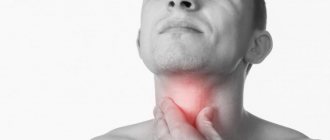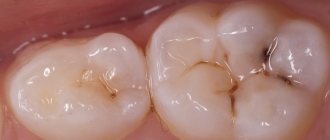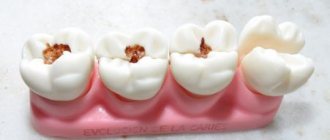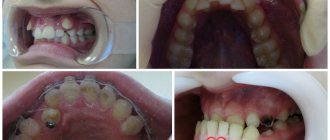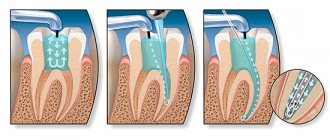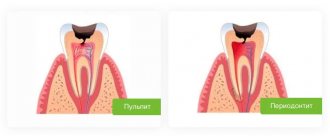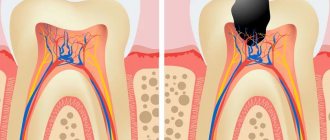Cemental caries, or root caries, is less common than cervical caries, but is considered more dangerous and destructive to the tooth. The fact is that the root walls are thin and therefore caries destroys them faster and reaches the pulp. Root caries often becomes a complication of cervical caries or occurs as an independent disease. Its official name is cement caries, which indicates the location of the lesion - under the gum. This is precisely the problem. Ordinary caries can be seen with the naked eye by characteristic spots, but root caries is invisible.
Theories of caries occurrence
Recent archaeological research confirms that even our ancestors, who lived more than five thousand years ago, suffered from caries. Information about the destruction of teeth similar to carious ones can be found in the works of ancient and ancient Eastern healers; in the Middle Ages, bad teeth were a widespread problem, and street teeth grinders became characters in folklore and even found their way into many literary works of those times.
The word “caries” itself came to us from Latin and literally means “rotting.” For the sake of fairness, it is worth noting that initially this name was poliomyelitis, but after that a disease that we all know was established under this name - an infectious process that destroys, and sometimes simply “devouring” a person’s teeth. The causes of caries and, as a consequence, ways to get rid of it occupied the minds of many learned men of antiquity and the Middle Ages. All sorts of assumptions have been made - from an excess of “bad juices” entering the body, which was used in antiquity (I must say, there is some truth in this, if by bad juices we mean all kinds of food acids), to “tooth worms” in the Middle Ages.
Advantages of the Novodent clinic
Many patients come to us from Khimki, Kursk, Novogorsk and other cities. The list of advantages of contacting us includes the following:
- Affordable prices for treatment, many special offers and discounts.
- High-quality provision of services for all categories of patients.
- Safe, proven preparations for fillings and anesthesia.
- High speed of completion of all tasks assigned to the doctor.
- Extensive consultations on all issues related to the prevention and improvement of oral health.
- Lots of services and treatment options.
- Advanced equipment and techniques.
Call us or leave a request on the website to make an appointment with a dentist at a convenient time.
Causes of dental caries
Today, debates about what caries is and why it happens are long gone. The cause of caries is known to everyone - it is carious bacteria that feed on carbohydrate residues from food and live in dental plaque. By the way, we are not born with these bacteria, they are not part of the original composition of our microflora, but once they enter the body, they settle in it forever. As a rule, “caries infection” occurs in childhood, and we perceive this disease from our own parents - most often through shared utensils. However, caries bacteria can lie dormant in our body for a long time, not manifesting themselves until the first opportunity.
And although caries is currently perhaps the most studied dental disease, the question still remains of how to stop caries - discoveries in this field are made almost every year.
Choosing a filling
Previously, mainly mineral cements, acrylic and epoxy, and amalgams were used to make fillings. Today, outdated fillings, which were imperfect in terms of fixation and aesthetics, have been replaced by modern inlays. They improve the adhesion strength to the tooth surface, do not require labor-intensive installation, and are biocompatible with the human body. Among them, the most used are: composites, glass ionomer cements, ormocers, compomers. Materials can be combined to achieve the desired effect.
Risk factors for dental caries
One of the most interesting questions is: why some people suffer from caries more often, while others less often, and whether there are those who do not suffer from it at all. Thus, modern theorists and practitioners of dental science identify several risk factors for caries. As you might guess, among these factors there are also very “selective” ones, that is, it is known for certain that some people are initially more predisposed to dental caries. Here are some signs that you should be concerned about tooth decay.
Risks of caries formation
- Flask-shaped fissures.
If there are many places on the surface of your teeth that seem to be created for the accumulation of plaque and the formation of carious cavities, then bacteria will not keep you waiting long. Thus, teeth with flask-shaped fissures (grooves on the chewing surface) are more susceptible to carious lesions. - Crowding of teeth and problems with bite.
Among the individual characteristics that make a person more vulnerable to caries are problems with bite, as well as teeth characterized by crowding - close arrangement relative to each other. On such teeth, which are very difficult, and sometimes impossible, to clean properly, contact caries often occurs. - Geography of residence.
People experience fewer and fewer tooth decay in areas with fluoridated tap water. - Professional activity.
Citizens who work with alkalis, acids and other harmful substances, on the contrary, are more susceptible to caries. - Age.
Baby teeth in young children very often become victims of carious bacteria, the greatest activity of which, however, occurs between the ages of 11 and 40 years. - Gender.
Women are more likely than men to suffer from this disease, which is primarily due to tooth decay during pregnancy.
The risk of caries is influenced by the quality of tooth enamel and pellicle - the thin organic film covering it, the work of the salivary glands and the chemical composition of saliva, diet and even sleep patterns.
How children are treated
Many patients think that baby teeth need not be treated. But this is a common misconception that can lead to serious problems.
If the caries of a baby tooth is not cured, there is a high probability that, as a result of the advanced disease, problems will arise with the change of the time series to the root one.
When treating a child, it is very important to fulfill several basic requirements at once:
- An individual approach to the child is important. Our clinic employs doctors who specialize in treating children. They know well how to calm a small patient and what to do so that he does not worry. This is important because it is in this case that it is possible to rid the child of fear of dentists in the future.
- Only specially selected anesthesia is used. It is important to use medications that are needed specifically for a child at a young age.
- Doctors always try to detect the disease at an early stage and do everything to cure it. This way, you can ensure that you do not have to use more traumatic methods for treatment.
Our dentists know well how to treat caries in baby teeth without pain and potential threats to the baby’s health.
Symptoms of caries
Caries will not be long in coming in the following cases: if you pay little attention to daily dental hygiene; with reduced immunity, for example, due to a long-term cold; if you eat a lot of fast carbohydrates.
Carious bacteria and the acid they secrete are very insidious - in the initial stages, caries is practically asymptomatic. That is why it is so important to regularly attend preventive examinations, during which the dentist has the opportunity to diagnose caries in the initial stages.
Prevention
To avoid the development of caries and its complications, experts advise following a few simple rules for preventing the disease:
- brush your teeth twice a day, use dental floss and mouthwash regularly;
- eat right - include foods rich in vitamins, calcium and phosphorus in your diet;
- give up bad habits - smoking, alcohol abuse;
- monitor the general condition of the body - periodically undergo tests at the clinic, undergo preventive examinations at least twice a year at the dentist.
In order not to lead to the development of complications of caries (pulpitis), in which it is necessary to remove the tooth pulp, fill the canals and restore most of the unit, pay attention to any unpleasant symptoms from the oral cavity. If you notice signs of tooth decay, contact your dentist immediately.
Author: Elena Kopylova Dentist-endodontist. Work experience more than 12 years.
The information is for reference only. Before treatment, consultation with a doctor is necessary.
The first signs of caries
- Stains on teeth.
The first signs of caries are spots on the enamel - they can be white, brown or even black. However, even such spots can be difficult to see on your own. - Pain from caries.
If you feel that a tooth has begun to react to sweet foods, cold and hot, then you should consult a dentist. - Hole due to caries.
If you can feel the hole in the tooth with your tongue, it means that caries has already developed into a more severe form and requires immediate treatment. - Bad breath due to caries.
When a person does not rush to the dentist, experimenting with caries treatment at home, teeth begin to rot and decay. The result is bad breath.
Modern dentistry – does it hurt?
Today it is logical to position the patient’s comfort on the same level as the results of therapy. Proper use of anesthesia in a dental clinic allows you to achieve the best results even in the most difficult cases.
Today's best method of pain relief in dentistry is the introduction of formulations based on articaine, a component that has minimal effects on the human vascular system and has a long-lasting effect.
In practice, there are several techniques for pain relief:
- applique. The doctor does not use a syringe or needle; the drug is applied to the mucous membrane in the form of a spray or using a gel-soaked tampon. This method of pain relief is used for relatively painless manipulations, for example, when giving injections to children;
- infiltration The doctor injects an anesthetic into the upper part of the tooth root. This anesthesia allows a person to be relieved of pain when treating deep caries of one tooth. The only condition for ensuring maximum effectiveness of the procedure is the introduction of the drug into the root of the upper tooth (due to the anatomical features of the jaw structure);
- conductor. The doctor injects the drug into the nerve or near the nerve trunk. The patient loses sensitivity in the local area for 2-3 hours;
- intraligamentary. Otherwise, the technique is called intraligamentous. The dentist injects an anesthetic with a special thin needle into the periodontium itself. This anesthesia allows you to “freeze” half of the jaw and lasts about 40 minutes. The method is most common in pediatric dentistry.
Stages of caries - types and intensity
Black's classification of caries is considered the most popular among modern dentists. According to this system, caries is divided into six classes depending on the location of carious cavities and the extent of dental caries.
Tooth enamel caries
Class I caries, or superficial caries,
As a rule, it affects the already mentioned fissures - grooves on the chewing teeth. Sometimes such caries is called caries in the spot stage; if you notice it in time and take action, you can even do without drilling with a drill and stop the carious process in the bud, preventing it from spreading deeper. If you miss the first signs, then the deterioration of the condition will not take long.
Contact type of caries
The next stage is class II caries
- often affects the contacts of chewing teeth, which is why it is sometimes called
contact caries
. At this stage, as at the previous one, caries does not bother its carrier and can go unnoticed for a long time.
Front teeth
Class III caries, or intermediate caries,
affects the contact surfaces of the front teeth. Many experts consider the best prevention against it to be flossing. Also, average caries is a disease of those with a sweet tooth.
Dentin caries
When treatment is not carried out, caries of the anterior teeth of the middle stage flows into the next class - IV
and already affects dentin.
Prikornevoy
Class V caries, also known as basal or cervical caries,
spreads along the gum line on both the front and chewing teeth. It manifests itself as increased sensitivity of the teeth in the area of the necks of the teeth. Typically, cervical caries occurs as a result of poor oral hygiene.
Atypical
Caries of the last class according to Black - VI - is also called atypical caries. This type of caries destroys the cutting edge and cusps of the teeth; scoop-shaped teeth are most susceptible to it.
It is also necessary to note three special categories of caries: multiple, recurrent and root caries. Their distinctive features are clear from their names, but let’s look at them in more detail.
Multiple dental caries
Multiple caries, also generalized or systemic,
affects a large number of teeth at once - from six to twenty, but even this is not enough for it - in each tooth affected by it, the dentist can find not one, but two or even three carious cavities. As you might guess, such caries develops quickly and can lead to the loss of several teeth or even an entire row of teeth. The causes of such a carious catastrophe are often immune, infectious and other severe general somatic diseases. Sometimes this happens to teenagers during puberty, when the body goes through a severe hormonal storm, which is why the immune system can also experience stress.
Secondary caries
Recurrent caries, also known as secondary,
as the name implies, it occurs in a previously affected, treated and filled tooth. The reasons for its return may be poor-quality treatment, as well as untimely replacement of fillings or other orthopedic structures - after all, fillings and crowns, although they last a long time, alas, do not last forever. Over time, they begin to adhere worse to the tooth tissues; saliva, bacteria, plaque, and food debris—true friends of caries—get into the gaps. Secondary caries can be distinguished by the brown outline at the junction of the orthopedic structure and dental tissues.
Root caries
Root caries
affects the roots of teeth exposed during gum recession. This type of caries is directly related to periodontal disease, malocclusion and age-related changes.
As the name suggests, root caries affects the exposed root of the tooth. This form is usually observed in older people and usually affects the lateral teeth. This is explained by the fact that with age, the risk of periodontitis increases, bone atrophy occurs, gums recede, and salivation decreases. First, the visible surface of the tooth root is affected, which becomes dark in color. Then, progressing, the carious lesion expands and completely covers the root part of the tooth. This often leads to a fracture with complete separation of the crown from the root (amputation caries). The disease often recurs if the root surface is left exposed and teeth are brushed irregularly or incorrectly.
So, as we have already found out, almost no one is immune from caries, and some people are at special risk groups from birth or due to their lifestyle. However, regardless of whether you have “aggravating circumstances”, the most important thing you need to remember is: good hygiene, regular preventive examinations coupled with professional cleaning and timely treatment of caries in the initial stages are the key to a beautiful and healthy smile for many years .
Clinical researches
The effectiveness of ASEPTA series products has been repeatedly proven clinically. For example, multiple clinical studies have demonstrated that using ASEPTA propolis gum gel for a week can reduce gum inflammation by 31%. And the two-component mouth rinse ASEPTA ACTIVE more effectively combats the causes of inflammation and bleeding compared to single-component rinses - it reduces inflammation by 41% and reduces bleeding gums by 43%.
Sources:
- Comparative clinical evaluation of the effectiveness of treatment of traumatic lesions of the oral mucosa IORDANISHVILI A.K. *,** Doctor of Medical Sciences, Professor, Professor of the Department *Department of Orthopedic Dentistry of the Federal State Budgetary Educational Institution of Higher Education “North-Western State Medical University named after. I.I. Mechnikov" of the Ministry of Health of the Russian Federation (rector - Doctor of Medical Sciences Sayganov S.A.); **Department of Maxillofacial Surgery and Surgical Dentistry of the Federal State Budgetary Military Educational Institution of Higher Education “Military Medical Academy named after S.M. Kirov" of the Ministry of Defense of the Russian Federation (chief - Corresponding Member of the Russian Academy of Sciences, Professor A.Ya. Fisun).
- The role of anti-inflammatory rinse in the treatment of periodontal diseases (L.Yu. Orekhova, A.A. Leontyev, S.B. Ulitovsky) L.Yu. OREKHOVA, Doctor of Medical Sciences, Prof., Head of Department; A.A. LEONTIEV, dentist; S.B. ULITOVSKY, Doctor of Medical Sciences, Prof. Department of Therapeutic Dentistry of St. Petersburg State Medical University named after. acad. I. P. Pavlova
- Report on the determination/confirmation of the preventive properties of personal oral hygiene products “ASEPTA PLUS” Remineralization doctor-researcher A.A. Leontyev, head Department of Preventive Dentistry, Doctor of Medical Sciences, Professor S.B. Ulitovsky First St. Petersburg State Medical University named after. acad. I.P. Pavlova, Department of Preventive Dentistry
- Report on determining/confirming the preventive properties of toothpaste “ASEPTA PLUS” COFFEE and TOBACCO Author: doctor-researcher A.A. Leontyev, head Department of Preventive Dentistry, Doctor of Medical Sciences, Professor S.B. Ulitovsky. First St. Petersburg State Medical University named after. acad. I.P. Pavlova, Department of Preventive Dentistry
- Report on determining/confirming the preventive properties of toothpaste “ASEPTA PLUS” GENTLE WHITENING” Author: doctor-researcher A.A. Leontyev, head Department of Preventive Dentistry, Doctor of Medical Sciences, Professor S.B. Ulitovsky First St. Petersburg State Medical University named after. acad. I.P. Pavlova, Department of Preventive Dentistry
